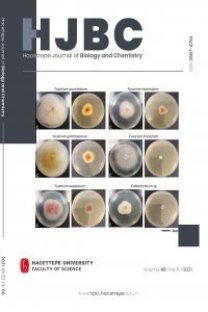Termofilik Anoxybacillus sp. Kullanarak Katı Faz Fermantasyonu (SSF) ile Isılkararlı α-Amilaz Üretimi
Production of Thermostable α-Amylase Through Solid State Fermentation (SSF) by Using Thermophilic Anoxybacillus sp.
___
- A.A. Saboury, Stability, activity and binding properties study of α-amylase upon interaction with Ca2+ and Co2+, Biologia, 57 (2002) 221–228.
- W.F. Li, X.X. Zhou, P. Lu, Structural features of thermozymes, Biotechnol. Adv., 23 (2008) 271–281.
- M. Michelin, T. M. Silva, V. M. Benassi, S. C. PeixotoNogueira, L. A. Moraes, J. M. Leão, J. A. Jorge, H. F. Terenzi, M. L. Polizeli, Purification and characterization of a thermostable a-amylase produced by the fungus Paecilomyces variotii, Carbohydrate Res. 345 (2010) 2348–2353.
- S. Özdemir, F. Matpan, V. Okumus, A. Dündar, M.S. Ulutas, M. Kumru, Isolation of a thermophilic Anoxybacillus flavithermus sp. nov. and production of thermostable α-amylase under solid-state fermentation (SSF), Ann. Microbiol., 62 (2012) 1367– 1375.
- B.L. Luiand, Y.M. Tzeng, Water content and water activity for the production of cyclodepsipeptide in solid state fermentation, Biotechnol. Lett., 21 (1999) 657–661.
- A. Pandey, C.R. Soccol, J.A. Rodriguez Leon, P. Nigam, Factors that influence on solid state fermentation. In: Pandey A, ed. Solid State Fermentation in Biotechnology: Fundamentals and Applications. New Delhi: Asiatech Publishers Inc., (2001) pp. 21–9.
- R.V. Feniksova, A.S. Tikhomirova, E.E. Rakhleeva, Conditions for forming amylase and proteinase in surface cultures of Bacillus subtilis, Microbiologia., 29 (1960) 745–748.
- M. Elibol, A.R. Moreira, Optimization some factors affecting alkaline protease production by a marine bacterium Teredinobacter turnirae under solidstate substrate fermentation, Process. Biochem., 40 (2005) 1951-1956.
- P. Turner, G. Mamoand E.N. Karlsson, Potential and utilization of thermophiles and thermostable enzymes in biorefining, Microbial. Cell Factories., 6:9 (2007) 1–23.
- K.S. Harmeet, S. Kanupriya, K.G. Jugal, K.S. Sanjeev, Production of a thermostable α-amylase from Bacillus sp. PS-7 by solid state fermentation and its synergistic use in the hydrolysis of malt starch for alcohol production, Process Biochem., 40 (2005) 525–534.
- P. Bernfeld, Amylases, α and β. In: Methods in Enzymology I. Academic, New York (1955).
- T. Aanniz, M. Ouadghiri, M. Melloul, J. Swings, E. Elfahime, J. Ibijbijen, M. Ismaili, M. Amar, Thermophilic bacteria in Moroccan hot springs, salt marshes and desert soils, Braz. J. Microbiol., 46 (2015) 443–453.
- K. Tamura, J. Dudley, M. Nei, S. Kumar, MEGA4: molecular evolutionary genetics analysis (MEGA), Mol. Biol. Evol., 24 (2007) 1596–1599.
- N. Mahanta, A. Gupta, SK. Khare, Production of protease and lipase by solvent tolerant Pseudomonas aeruginosa PseA in solid-state fermentation using Jatropha curcas seed cake as substrate, Bioresour. Technol., 99 (2008) 1729–1735.
- A. Kunamneni, K. Permaul, S. Singh, Amylase production in solid-state fermentation by the thermophilic fungus Thermomyces lanuginosus, J. Biosci. Bioeng., 100 (2005) 168–171.
- K.R. Babu, T. Satyanarayana, α-Amylase production by thermophilic Bacillus coagulans in solid state fermentation, Process, Biochem., 30 (1995) 305–309.
- S.M. Kotwal, M.M. Gote, S.R. Sainkar, M.I. Khan, J.M. Khire, Production of α-galactosidase by thermophilic fungus Humicola sp. in solid state fermentation and its application in soya milk hydrolysis, Process Biochem., 33 (1998) 337–43.
- D.H. Bergey, Thermophilic bacteria, J. Bacteriol., 4 (1919) 301–306.
- C.R. Soccol, L.P.S. Vandenberghe, Overview of solid state fermentation in Brazil, Biochem. Eng. J., 13 (2003) 205–218.
- R.Kuhad, D. Deswal, S. Sharma, A. Bhattacharya, K. Jain, A. Kaur, Revisiting cellulase production and redefining current strategies based on major challenges, Renew. Sust. Energ. Rev., 55 (2016) 249–272.
- D. Pessoa, A. Finkler, A. Machado, L. Luz, D. Mitchell, Fluid dynamics simulation of a pilot-scale solid-state fermentation bioreactor, Chem. Eng. Trans., 49 (2016) 49–54.
- C.R. Soccol, E.S. Ferreira da Costa, L.A.J. Letti, S.G. Karp, A.L. Woiciechowski, L.P.S. Vandenberghe, Recent developments and innovations in solid state fermentation, Biotechnology Research&Innovation., 1 (2017) 52-71.
- A. Pandey, Solid-state fermentation, Biochem. Eng. J.,13 (2003) 81–84.
- M. Asgher, M.J. Asad, S.U. Rahman, R.L. Legge, A thermostable α-amylase from a moderately thermophilic Bacillus subtilis strain for starch processing, J. Food. Eng.,79 (2007) 950–955.
- B. Arikan, Highly thermostable, thermophilic, alkaline, SDS and chelato rresistant amylase from a thermophilic Bacillus sp. Isolate A3-15, Bioresour. Technol., 99 (2008) 3071–3076.
- A. Pandey, C.R. Soccol, P. Nigam, V.T. Soccol, Biotechnological potential of agro-industrial residues: I. Sugarcane bagasse, Bioresour. Technol., 74 (2000) 69–80.
- R.K. Saxena, K. Dutt, L. Agarwal, P. Nayyar, A highly thermostable and alkaline amylase from a Bacillus sp. PN5, Bioresour. Technol., 98 (2007) 260–265.
- R. Gupta, P. Gigras, H. Mohapatra, V.K. Goswami, B. Chauhan, Microbial a-amylases: A biotechnological perspective, Process Biochem., 38 (2003) 1599–1616.
- ISSN: 2687-475X
- Yayın Aralığı: 4
- Başlangıç: 1972
- Yayıncı: Hacettepe Üniversitesi, Fen Fakültesi
Necla PEHLİVAN, Nuran DURMUŞ, Sengül Alpay KARAOĞLU, Abdullah M. YEŞİLYURT
Famil NASİBOV, Turane MAMADOVA
Olefin Metatez Tepkimeleri ile Norbornen İçeren Fonksiyonel Poliesterlerin Modifikasyonu
Aylin ALTINIŞIK TAGAÇ, Önder SARP, Kadir YURKAKOÇ
Olgun GÜVEN, Meshude AKBULUT SÖYLEMEZ
Türkiye Florası için Yeni Bir Tür Kaydı; Parietaria rechingeri Chrtek (Urticaceae)
C Vitaminin Kitosan Nanoparçacıklardan Kontrollü Salımı
